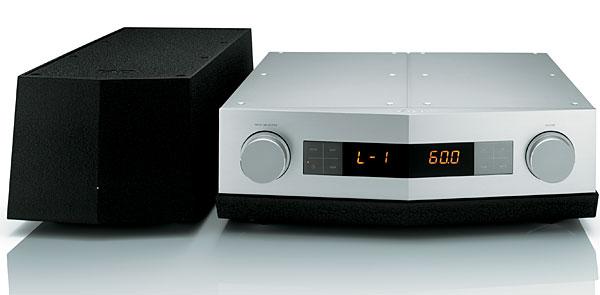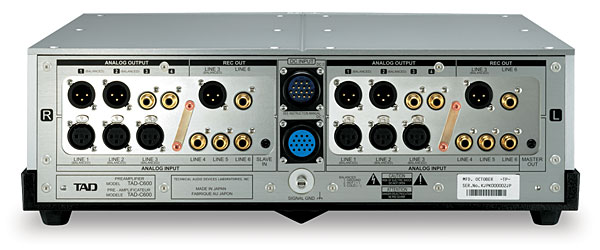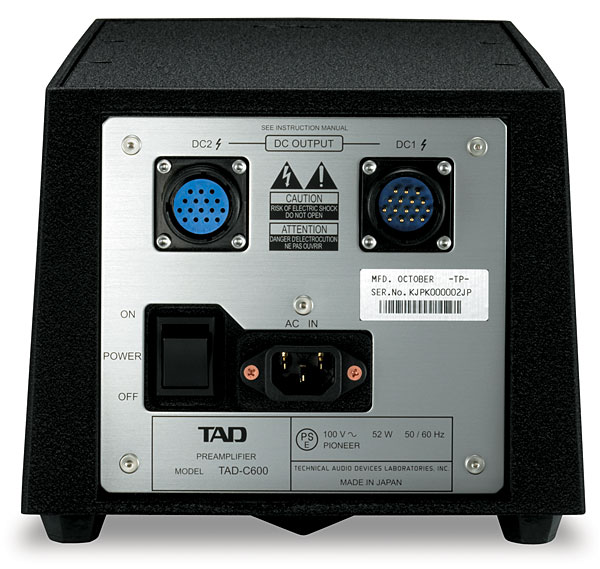| Columns Retired Columns & Blogs |
Nice audio component,but very expensive.

Much of what's under the hood of the high-tech C600 would probably be unrecognizable to most '70s-era audio designers. Its robust build quality and the elegance of its operating system would be the envy of all them, and of many now.
Technical Audio Devices Laboratories, Inc., better known as TAD Labs or simply TAD, is an offshoot of Pioneer Electronics, which made Kuro plasma video displays, still considered the finest flat-panel TVs ever made, and automotive sound systems. Older audiophiles remember the robust line of well-regarded receivers and integrated amplifiers Pioneer made in the 1970s—if they can remember the '70s at all.
Pioneer's investments in basic speaker R&D began in the 1970s, with their establishment of a "laboratory grade" division that developed, among other innovations, a beryllium cone used in a series of speaker models aimed at the professional audio market.
In 2008, Pioneer, then celebrating its 70th anniversary, created TAD as an independent company, and named former KEF speaker designer Andrew Jones as head of R&D. At that year's Consumer Electronics Show, Jones introduced the TAD Reference One loudspeaker, which is highly regarded and still in production.
At CES 2012, TAD debuted the C600 preamplifier, thus completing the Reference Series line, which comprises the Reference One and Compact Reference CR1 speakers, the D600 SACD/CD player, and the M600 monoblock power amplifier. The sound in TAD's room, with demos overseen by Jones, has been, for the past few years, a consistent highlight of CES, and the C600's arrival was accompanied by high expectations.
Outside
The C600's industrial design was done in-house, following the styling set by Bo Christensen (Primare, Bow Tech), who was responsible for the appearance of the D600. It features a thick, blunt-prowed faceplate of brushed anodized aluminum and a case of the same material, sitting on a massive, rugged base of black, pebble-grained aluminum, designed to minimize the sonic effects of vibrational energy on the electronics inside.
The C600 weighs 63.8 pounds, almost half of which is that base, itself supported by three squat aluminum cones: two in front, one in back. Two small rubber feet at the rear corners prevent tipping. The C600 is heavy but of modest size: 17.5" wide by 5.9" high by 17.2" deep; it should easily fit in most racks.

The external, power supply contains a toroidal transformer rated at 400VA, and rectification and filtering components befitting a power amplifier, housed in an all-business case of pebbly black aluminum almost a foot and a half long and weighing 33 lbs. It connects to the C600 via a pair of 6'-long, thick umbilicals terminated in "industrial strength" multi-pin plugs. If the goal was to suggest a power plant, mission accomplished.
The C600's front panel is dominated by two large knobs, for volume and source selection, flanking a wide, easily read display of yellow LEDs that are DC-powered to eliminate EMI interference. On each side, between big knob and display, are two sets of four pushbuttons, each set hidden behind a metal panel. The four buttons on the left control On/Standby, Display On/Off, and entering and exiting the menu system. Two of the four buttons on the right control settings within the menu system; there are also Mute and Fine buttons, the latter switching the increments of volume adjustment from 1.0 to 0.5dB. In Menu mode you can adjust the left/right balance, set individual input levels within a range of –10 to +20dB, and set the outputs of inputs 2 and 5 to unity gain—for use, say, with an outboard surround-sound processor. You can specify that all outputs remain active (the default setting), or only outputs 1 and 3, or outputs 2 and 4.
On the cleanly laid-out rear panel are three sets each of balanced XLR and single-ended inputs, plus two pairs of balanced and single-ended outputs, as well as single-ended and balanced record outputs. At the center of the panel are two multi-pin power jacks, which also serve to separate the left- from the right-channel connectors. Jacks are included for multi-preamp slaving, though I doubt many audiophiles will make use of them. Directly below the power supply connectors is a ground lug similar to the kind found on phono preamps; it provides a handy way to star-ground multiple components.

A long, thin remote control of aluminum and plastic has pushbuttons that control basic functions: On/Standby, selection among the six inputs, Display On/Off, Volume, and Mute.
Inside
The C600's dual-mono interior, featuring much copper shielding, is as attractive as its exterior, and features what TAD describes as "the highest quality and precision dedicated parts," including a "custom electronic volume control featuring super-precise ball bearings. TAD's new ladder-resistance switching electronic volume control circuit achieves an absolute channel level difference of 0.1 dB or less even at attenuations of more than 100dB with harmonic distortion at only 0.0005% (at 1V RMS input)." Each channel's electronics are on a separate circuit board, one on each side of the chassis, separated by a section containing the incoming power from the outboard supply.
The input selector has the same ultra-precise ball bearings as the Volume knob. These felt smooth, solid, and secure as I clicked through the inputs (you can continuously turn from input 6 back to input 1) and adjusted the volume. Both are encoder-type controls.
Each input appears to be associated with a separate, relay-controlled preamplifier (with its own signal path, connected to the output via another set of output relays), ladder resistor attenuator, and gain stage using pairs of large transistors mounted on hefty heatsinks. To switch among inputs is to literally switch among separate preamps. Everything about the circuit layout and construction appears to be of the highest caliber, although some audio purists might sniff at the surface-mount technology.
Setup and Use
Hooking up the C600 was relatively straightforward, with one wrinkle: To prevent the squeal of a tape-feedback loop when using the single-ended Tape Out jacks, you can't record from input 6. If you use the balanced Tape Out jacks, you can't record from input 3. So if you wish to record, choose inputs carefully. The designer has evidently assumed that you'll connect the recorder's output to one of the inputs, so there's no need for the device's output to loop back to the input.
Depending on your gear, a total of three single-ended and three balanced inputs may not be enough. If you need more single-ended inputs, you can always use high-quality RCA-to-XLR adapters, such as those made by Balanced Audio Technology.
Though the C600 is a balanced design (it's not dual-differential), I ran it single-ended into the darTZeel NHB 458 monoblocks.
A Straight Wire with Gain?
Can any preamplifier actually be a straight wire with gain? Not really, though some come closer than others to that ideal. But some don't even try. They try to output a signal that's better than what enters, and there's absolutely nothing wrong with that. Nonetheless, most of us probably want little more from a preamplifier than a quiet, low-distortion device that can efficiently route various sources to an amplifier while adding to and/or subtracting from the original signal as little as possible.